Intel Woodcrest: the Birth of a New King
by Jason Clark & Ross Whitehead on July 13, 2006 12:05 AM EST- Posted in
- IT Computing
Architecture Summary
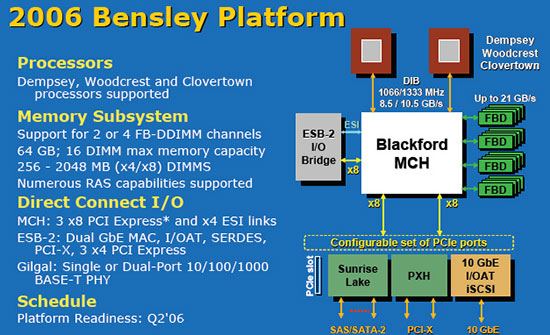
Woodcrest's home is a newer revision of the Bensley platform than what Dempsey launched with, which means that it's a drop-in part for newer Bensley based systems. If all goes to plan Clovertown (Quad-Core Xeon) should be a drop-in upgrade as well (depending on the system vendor). As we discussed in our Dempsey article, the Bensley platform features FB-DIMM with a peak bandwidth of 21GB/sec, SAS/SATA support and 1066/1333MHz FSB.
Woodcrest Highlights:
Shared 4MB L2 "Smart Cache"
Dempsey based processors had a separate 2MB L2 cache for each core, but Woodcrest has 4MB of L2 Cache shared between both cores. Due to the fact that the cores share a single cache, there is no data replication like there is with separate L2 caches; this results in more efficient data-sharing between cores. The shared cache also helps with mismatched loads: when one core is consistently using more cache than the other core, the CPU can allocate more L2 cache to that core. Both of these techniques are illustrated below.
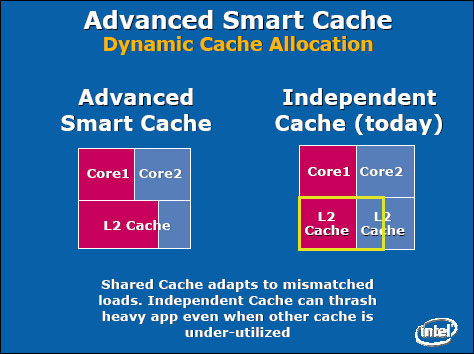
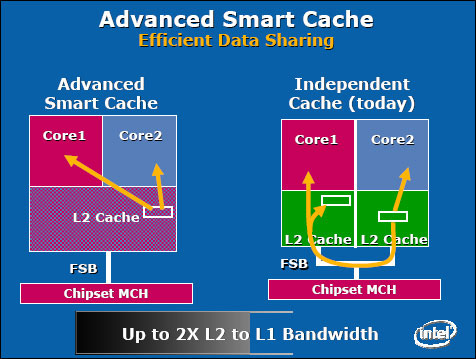
Wide Dynamic Execution Enhancements
With the Intel Core micro-architecture, every execution core is 33% wider than previous generations, allowing each core to fetch, dispatch, execute and retire up to four full instructions simultaneously. The Opteron - as well as all previous NetBurst Xeon processors - can only handle 3 at a time.
Macro Fusion
Macro-fusion combines certain common x86 instructions into a single instruction for execution. Without Macro-fusion four instructions at a time are fetched from the queue and each instruction gets decoded into separate micro-ops. With Macro Fusion, 5 instructions can be fetched at a time, and if a fusable pair is present it can be sent to a single decoder. A single micro-op can then represent two regular x86 instructions.
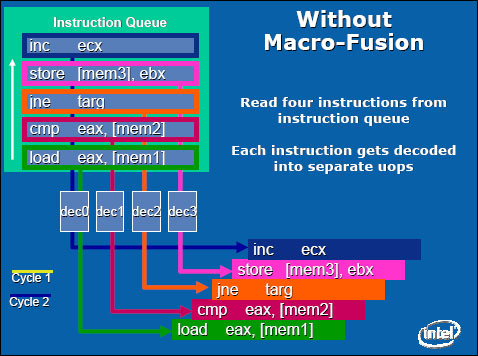
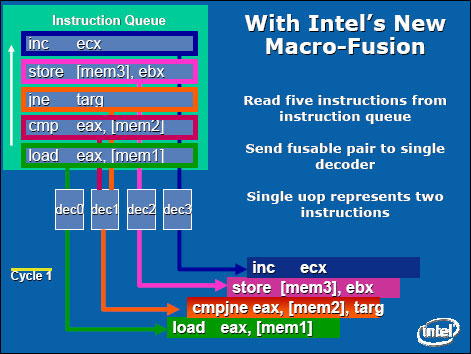
Beyond 2 Sockets, is Intel's FSB still an Achilles Heel?
As we've seen in past benchmarks, the front side bus has been a thorn in Intel's side, especially in the quad socket systems. Whether or not the new architectural changes that Intel has made with Woodcrest will alleviate enough of that pressure to overpower the scalability of Opteron in four socket configurations is unknown at this point. Intel is quite confident that with the shared cache and its dual independent FSB running at 1333MHz that bus bandwidth is not a concern, however at some point the bus bottleneck will be a problem. One of Intel's architects has however stated that an integrated memory controller is possible, which Intel has already shown us a demo of.

Woodcrest's home is a newer revision of the Bensley platform than what Dempsey launched with, which means that it's a drop-in part for newer Bensley based systems. If all goes to plan Clovertown (Quad-Core Xeon) should be a drop-in upgrade as well (depending on the system vendor). As we discussed in our Dempsey article, the Bensley platform features FB-DIMM with a peak bandwidth of 21GB/sec, SAS/SATA support and 1066/1333MHz FSB.
Woodcrest Highlights:
Shared 4MB L2 "Smart Cache"
Dempsey based processors had a separate 2MB L2 cache for each core, but Woodcrest has 4MB of L2 Cache shared between both cores. Due to the fact that the cores share a single cache, there is no data replication like there is with separate L2 caches; this results in more efficient data-sharing between cores. The shared cache also helps with mismatched loads: when one core is consistently using more cache than the other core, the CPU can allocate more L2 cache to that core. Both of these techniques are illustrated below.


Wide Dynamic Execution Enhancements
With the Intel Core micro-architecture, every execution core is 33% wider than previous generations, allowing each core to fetch, dispatch, execute and retire up to four full instructions simultaneously. The Opteron - as well as all previous NetBurst Xeon processors - can only handle 3 at a time.
Macro Fusion
Macro-fusion combines certain common x86 instructions into a single instruction for execution. Without Macro-fusion four instructions at a time are fetched from the queue and each instruction gets decoded into separate micro-ops. With Macro Fusion, 5 instructions can be fetched at a time, and if a fusable pair is present it can be sent to a single decoder. A single micro-op can then represent two regular x86 instructions.


Beyond 2 Sockets, is Intel's FSB still an Achilles Heel?
As we've seen in past benchmarks, the front side bus has been a thorn in Intel's side, especially in the quad socket systems. Whether or not the new architectural changes that Intel has made with Woodcrest will alleviate enough of that pressure to overpower the scalability of Opteron in four socket configurations is unknown at this point. Intel is quite confident that with the shared cache and its dual independent FSB running at 1333MHz that bus bandwidth is not a concern, however at some point the bus bottleneck will be a problem. One of Intel's architects has however stated that an integrated memory controller is possible, which Intel has already shown us a demo of.










59 Comments
View All Comments
Lonyo - Thursday, July 13, 2006 - link
What's the fastest Opteron dual core CPU you can buy?What's the fastest Woodcrest CPU that will be released?
AMD don't make anything faster than 2.6GHz, so it doesn't really matter what speed Intel have to be at to beat it, they beat it with their top end part. And the Opteron is nearing its end (at 90nm), Woodcrest is new, so it will go faster probably, same as 65nm Opterons will go faster.
Woodcrest is not behind Opteron, it is better per watt, and the high end Woodcrest beats the high end Opteron. Enough said. Whether Intel is clock for clock better or not still doesn't matter. They are better, and if they are not better clock for clock, it doesn't seem to matter because, again, they have higher clocks.
Spoonbender - Thursday, July 13, 2006 - link
"What's the fastest Woodcrest CPU that will be released? "Umm.... None?
Does that mean AMD beats Intel by an infinite margin then?
True, if Intel has a 3ghz part out, and AMD only has 2.6, then it makes sense to compare these two.
But for now, let's just keep in mind that Intel doesn't have a 3ghz part out. They don't have a 2.6GHz part either. We are still comparing an unreleased product to one that has been out for a while.
Cooler - Thursday, July 13, 2006 - link
Their on new egg right now...http://www.newegg.com/Product/ProductList.asp?Subm...">http://www.newegg.com/Product/ProductLi...rchInDes...
xtremejack - Thursday, July 13, 2006 - link
You should note the way the two processors are compared here. Both are dual-CPU systems. Intel's FSB based system architecture means lower system bandwidth than AMD's DirectConnect architecture. The Opteron's have an on-die memory controller and a point-to-point interconnect. I am sure if you put Woodcrest on a Paxville system, you would see significantly worse performance. The 3.0Ghz Woodcrest is probably capable of a bit more performance, but the lower bandwidth FSB does not help it reach its full potential. Also coupled with the fact that FB-DIMMS have more latency than standard DDR2 means the Woodcrest isn't at a serious advantage compared to the Opteron system.Bottom-line system performance for the Woodcrest processor is still 5-20% better than Opteron. But thats way better than being 30% lower during Paxville days.
Now Conroe does not have all these complications that Woodcrest has, thats why you may see better performance advantage, also since it is a single-CPU solution, the system architecture is much simpler.
swtethan - Thursday, July 13, 2006 - link
how many people running servers are going to overclock their system? :Dfitten - Thursday, July 13, 2006 - link
Zero. I'd fire any IT person on the spot if I found out they had overclocked a production server.FesterOZ - Thursday, July 13, 2006 - link
I find this article somewhat surprising in tone. My company is a Fortune 500 and a big Dell shop so we have had access to Woodcrest workstations and servers for testing for a while. We have also tested these vs HP 9300 Athlon based Workstations and vs Sun x4100 servers and HP DL385s. Based on our tests which involve business applications, trading applications, etc., the performance of Woodcrest vs the Athlons is slightly better (about 5-10%). Nothing to really rave about, especially when its the latest Intel designs on 65nm. This actually disappointed our in-house Dell groupies, especially since they were comparing the top of the line new CPU design from Intel vs AMD's older platform. As a result we are moving away from Dell simply because they do not offer choice of CPU's at the moment and into HP's world, with our first purchase being 3 full chassis of AMD blade servers.IMHO, its now a two baron world with a missing king, each with strenghts and weaknesses.
Kiijibari - Thursday, July 13, 2006 - link
>IMHO, its now a two baron world with a missing king, each with strenghts and weaknesses.Yes I back that opinion.
Woodcrest is hampered by its FBDs. While it delivers much better bandwidth, it has worse latencies. Furthermore the 4 MB L2 cache & Core2 prefetch does not help that much in a multithreaded server environment, than in the average desktop application area.
What I want to say is, that the performance difference between Conroe/Athlon64 will be bigger than that between Woodcrest/Opteron.
First "tests"( I was told by an administrator of a huge financal institute) also showed a Woodcrest performace lack with gcc compiled 64bit applications. Are some of your applications 64bit, too ? It would be interesting, to get more 64bit statments. For some reason, there are none from Intel so far ...
cheers
Kiijibari
Spoonbender - Thursday, July 13, 2006 - link
Yes, I've been wondering about 64-bit performance too. Intel hasn't mentioned it with a word, but I hope they've made a decent implementation this time around.duploxxx - Thursday, July 13, 2006 - link
no they didn't, still the same as in the Netburst. some small 64bit testing has been done on XS forums seeing a core architecture gaining 17-18% performance on a 64bit os + program like 64bit cinebench. the opty 940 gained 31-38%